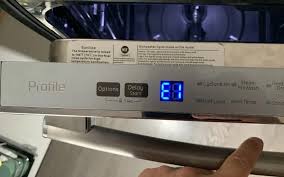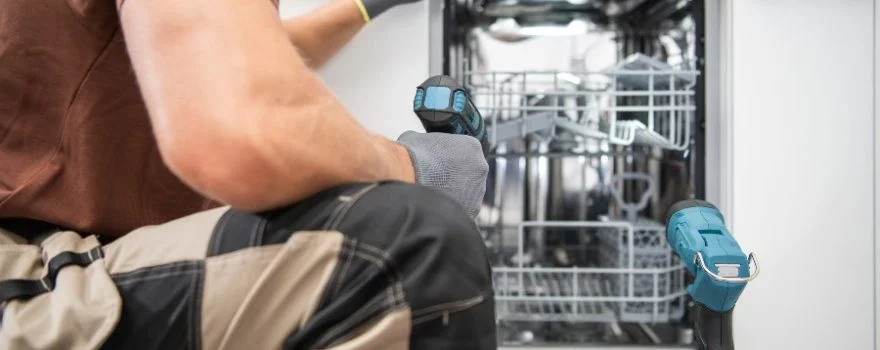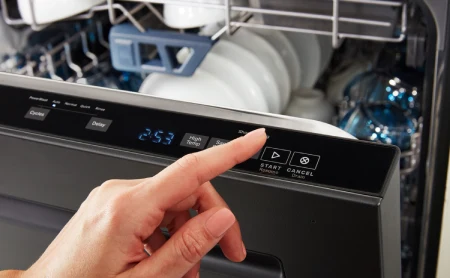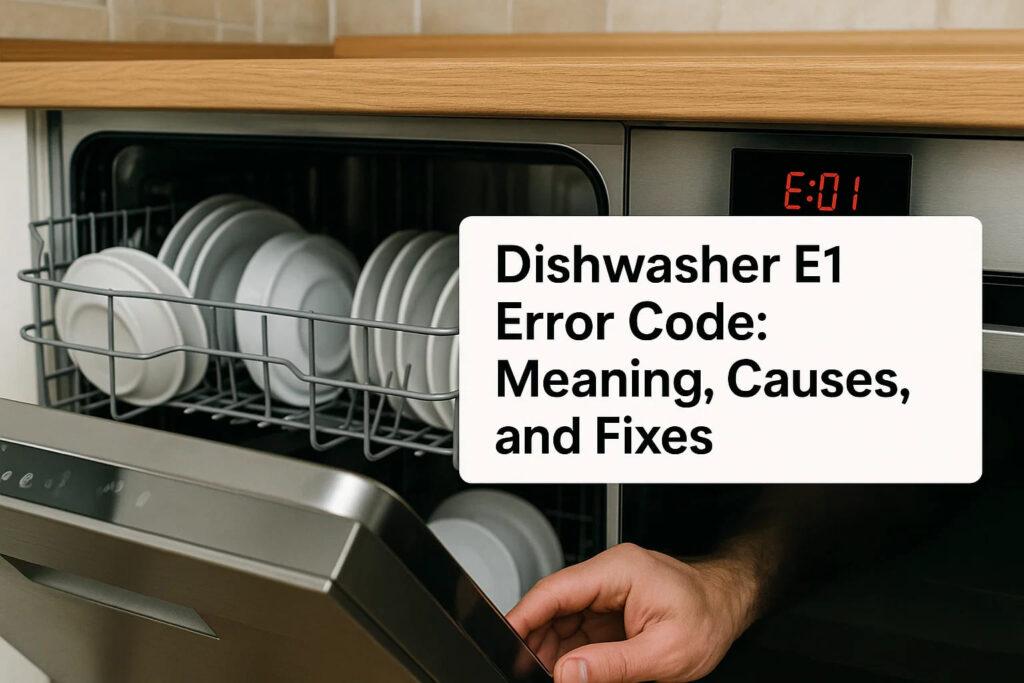Looking for a fast, local fix? If you’re in NYC, you can book a local GE dishwasher repair in New York while you read this guide.
What “GE dishwasher E1 error code” means:
On many GE and GE Profile models, E1 = leak detected in the base (the flood/float switch has tripped). On a smaller set of models, E1 flags a water-inlet/fill fault (the machine didn’t reach the expected fill level in time). The label can vary by series and production year—always confirm with your specific model’s owner’s manual.
What Does the GE Dishwasher E1 Error Code Mean?
Most GE/GE Profile/Adora units treat E1 as a leak condition: water collects in the base pan, the flood sensor notices, and the control stops the cycle to prevent further damage.
However, some platforms reuse E1 for fill/inlet issues—think closed water supply, low pressure, or a clogged inlet screen—so the tub never fills as expected.
Why the meaning differs: GE has multiple control platforms across years and sub-brands. Firmware and display codes shift slightly between them. That’s also why certain models show “H2O” for low fill instead of E1.
Quick check: locate your model tag (usually on the tub frame) and pull the correct owner’s manual. That document is the tie-breaker for what E1 means on your machine.
Common Symptoms You’ll See With an E1 Code
- Cycle stops early; drain or circulation pump runs repeatedly.
- “E1” flashes with beeps.
- Leak scenario: water in the base pan or a small puddle under the dishwasher.
- Inlet scenario: unusually long fill time, or you don’t hear the tub filling.
| Scenario | Typical Symptoms | Likely Causes | DIY Fixes | When to Call a Pro |
|---|---|---|---|---|
| E1 = Leak Detected | Stops mid-cycle; beeping; water in base/puddle | Loose hose/clamp, worn door gasket, leaky valve, cracked sump/base | Dry base pan; tighten/replace hoses; replace door gasket; inspect sump/valve | Persistent leaks, cracked plastic, soaked flood switch, repeated E1 |
| E1 = Water-Inlet Fault | Long/no fill; quiet tub; immediate E1 on start | Closed supply, low pressure, clogged screen, bad inlet valve, flow-meter issue | Open supply, unkink line, clean screen, replace inlet valve, verify 40–60 psi | Electrical faults, control board errors, repeated fill timeouts |
| False Trip / Siphoning | Intermittent E1, odd draining sounds | Drain hose too low; no high loop/air gap; suds | Add high loop/air gap; correct detergent; purge suds | If code persists after rerouting and de-sudsing |
Root Causes of a GE Dishwasher E1 Error Code
Leak-related (most reported)
- Loose or cracked drain hose or clamps
- Split circulation or inlet hose
- Worn door gasket or misaligned door latch
- Leaky inlet valve or sump assembly
- Over-foaming from the wrong detergent or too much rinse aid
- Cracked tub or base pan
Water-inlet/fill faults (some models)
- Water supply closed, kinked, or pressure too low
- Clogged inlet screen; failing inlet valve
- Faulty flow meter or pressure/fill switch
- Siphoning due to incorrect drain-hose routing (no high loop/air gap)
- Control board/PCB logic fault (rarer)

Safety First
- Power off at the breaker and shut the water supply before moving the unit.
- Protect floors (towels, tray) and only pull the machine if you can do so safely.
Step-By-Step: How to Fix a GE Dishwasher E1 Error Code (DIY)
- Confirm your model’s definition of E1.
Grab the model number and check the correct manual. If the manual says E1=leak, treat it as a leak; if E1=fill, focus on supply and inlet parts. - Check for water in the base pan (leak version).
- Remove the toe-kick.
- Use a flashlight to look for standing water.
- Dry the pan (towels, sponge) and watch carefully during a short test fill to find the source.
- Inspect: hose clamps, sump, inlet valve body, circulation pump housing, and the door gasket corners.
- Inspect the door and detergent use.
- Replace a flattened, nicked, or brittle door gasket.
- If you used regular dish soap or too much detergent, clear excess suds (add a splash of cold water, run a brief drain, repeat until suds are gone).
- Verify water-inlet basics (fill version).
- Ensure the supply valve is fully open.
- Straighten any kinks; check household pressure (ideally ~40–60 psi).
- Clean the inlet screen (at the valve) and consider replacing an aging inlet valve.
- Fix drain-hose routing to prevent siphoning.
- Add/restore a high loop under the counter or connect to an air gap.
- Keep the hose length and height within GE’s specs.
- Run a short test cycle.
- Watch the first 5–10 minutes: fill, wash start, and any abnormal drips.
- If E1 returns immediately, recheck the sensor area; a stuck or water-logged flood switch may need replacement.
Need a hand mid-repair? You can book a same-day dishwasher technician in NYC to take over the tricky bits.

How to Reset a GE Dishwasher After an E1 Error
- Universal power reset: switch the breaker off for 2–5 minutes, then restore power.
- Panel/button resets vary by platform (and won’t clear a real leak). Use your model’s manual for the exact combo.
- If the base pan still has water, the code will return—fix the cause first, then reset.
When to Call GE or a Technician
- E1 returns after you’ve dried the base and corrected hose routing.
- You see cracked plastic, a corroded or leaking valve, or damage to the sump/pump.
- Suspected sensor (flood switch/flow meter) or control board faults.
NYC homeowners can get professional help via ExpressRepair NY — dishwasher repair in New York.
Model-Specific Notes (GE vs GE Profile)
- Many GE and GE Profile models: E1 = leak detected in the base (flood sensor trip).
- Some platforms (often with different control boards): E1 = fill timeout (inlet fault).
- H2O on other models means insufficient fill—not the same as E1, but the symptoms can overlap (long fill, dry spray).
Preventing a Future GE Dishwasher E1 Error
- Use dishwasher-safe detergent only; measure properly.
- Clean the filter/sump monthly; wipe door gasket and corners.
- Keep the drain hose high loop/air gap intact.
- Inspect the supply line and inlet screen every 6–12 months.
- After any plumbing work, run and watch one full cycle for drips.

Need professional help in NYC?
Get reliable, on-site diagnostics and repair from ExpressRepair NY’s GE dishwasher repair page—handy if you’d rather skip the crawling under the sink.
FAQs
Is it safe to run the dishwasher with an E1 error?
No. If it’s a leak, you risk property damage. If it’s inlet-related, you can overheat the pump.
Where is the flood/float switch and how do I dry the base?
It sits in the base pan below the tub. Remove the toe-kick, unplug power, and soak up water with towels. Avoid tipping the unit sharply—spillage can reach the wiring.
What tools do I need?
Towels, a flashlight, nut driver or Torx bit (for panels), hose clamps, and possibly a new door gasket or inlet valve.
E1 shows but I don’t see water—what now?
Focus on inlet pressure, the inlet valve, and drain-hose siphoning. Also consider a stuck or water-logged flood switch.
Is E1 the same as H2O?
No. E1 may indicate leak or fill depending on model; H2O is generally low/no fill.
